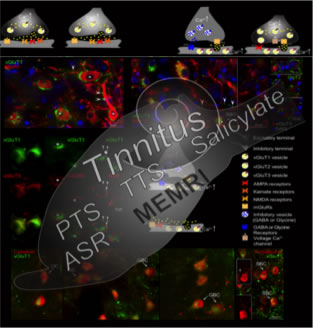MAAP - Morphological Assessment of Auditory Pathways
 Spinning Proton Magic Angle Magnetic Resonance Spectroscopy (HR-MAS 1 H-MRS)
Spinning Proton Magic Angle Magnetic Resonance Spectroscopy (HR-MAS 1 H-MRS)
Recent advances in tinnitus research suggest that there may be a neurochemical basis for tinnitus. Partial or complete peripheral deafferentation from acoustic trauma may result in a cascade of neurochemical changes in both the peripheral and central auditory systems, producing an imbalance between inhibitory and excitatory inputs to auditory neurons at various levels along the auditory pathway. Using HR-MAS 1 H-MRS, we are examing neurochemical profiles from brain regions of noise-exposed animals with behavioral evidence of tinnitus.
Development of Dual Targeted Nanoparticles for Delivery to Tinnitus Affected Brain Regions
Tinnitus has been linked with spatial and temporal changes in neuronal activity. Targeting tinnitus-related brain regions via delivery of theranostic nanoparticles (NPs) could facilitate diagnostics and delivery of drugs to modulate neuronal activity and alleviate symptoms of tinnitus. Fundamental challenges for reaching this goal are detection of brain regions that demonstrate changes in neuronal activity following tinnitus onset and the delivery of functional nanoparticles specifically to these regions. We are currently testing nanoparticles with various designs to determine the optimal method for targeting and delivering therapeutic compounds of interest, ultimately in tinnitus models.
